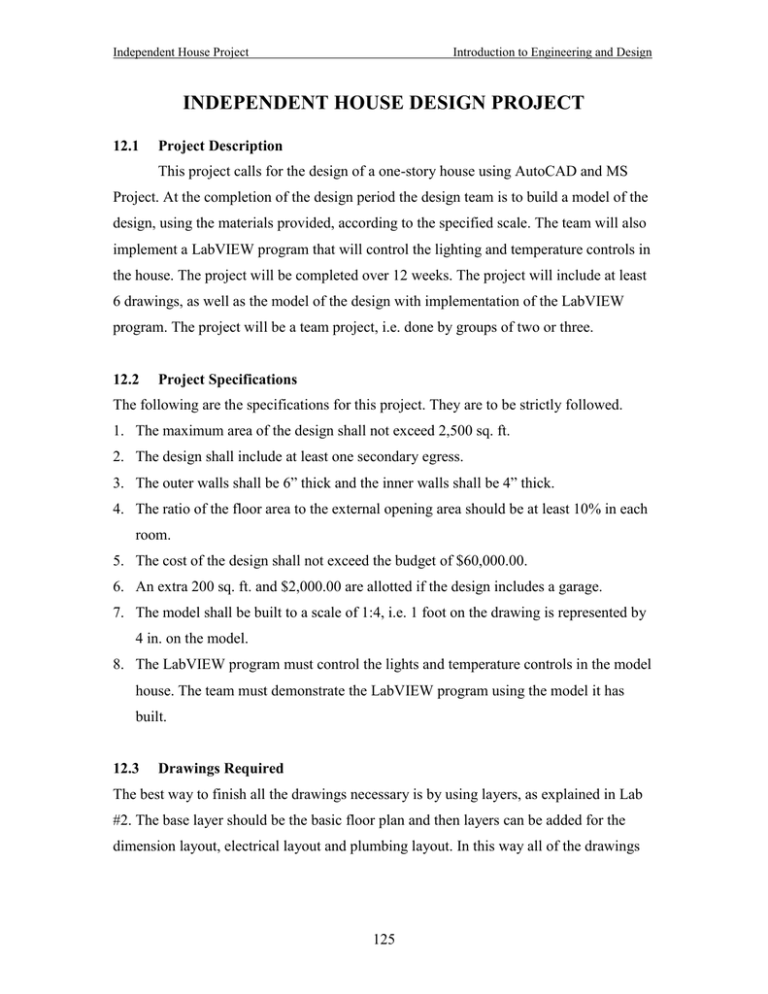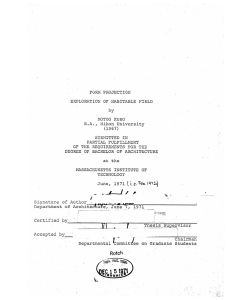Document 14602692
advertisement

Independent House Project Introduction to Engineering and Design INDEPENDENT HOUSE DESIGN PROJECT 12.1 Project Description This project calls for the design of a one-story house using AutoCAD and MS Project. At the completion of the design period the design team is to build a model of the design, using the materials provided, according to the specified scale. The team will also implement a LabVIEW program that will control the lighting and temperature controls in the house. The project will be completed over 12 weeks. The project will include at least 6 drawings, as well as the model of the design with implementation of the LabVIEW program. The project will be a team project, i.e. done by groups of two or three. 12.2 Project Specifications The following are the specifications for this project. They are to be strictly followed. 1. The maximum area of the design shall not exceed 2,500 sq. ft. 2. The design shall include at least one secondary egress. 3. The outer walls shall be 6” thick and the inner walls shall be 4” thick. 4. The ratio of the floor area to the external opening area should be at least 10% in each room. 5. The cost of the design shall not exceed the budget of $60,000.00. 6. An extra 200 sq. ft. and $2,000.00 are allotted if the design includes a garage. 7. The model shall be built to a scale of 1:4, i.e. 1 foot on the drawing is represented by 4 in. on the model. 8. The LabVIEW program must control the lights and temperature controls in the model house. The team must demonstrate the LabVIEW program using the model it has built. 12.3 Drawings Required The best way to finish all the drawings necessary is by using layers, as explained in Lab #2. The base layer should be the basic floor plan and then layers can be added for the dimension layout, electrical layout and plumbing layout. In this way all of the drawings 125 Independent House Project Introduction to Engineering and Design can be in one file rather than 3 or 4 separate files. Also line-type is very important when it comes to drawings. Refer to Lab #2. The requirements for each layout are as follows: 12.3.1 Floor plan The basic floor plan shall show the basic layout of all the rooms in the house. These rooms should be clearly labeled. 12.3.2 Dimension Layout This drawing must show in detail the dimensions of the design. It is intended that the design can be constructed from this layout. The dimensions are to be in engineering format (1.50’) and not in architectural format (1” 6 ¾”). As much as possible, try to keep dimensions on the outside of the house for visual clarity. 12.3.3 Electrical Layout This drawing must show the electrical fixtures in the design, i.e. all the lights, switches and electrical outlets (110V and 220V). Please note that all lights must be connected to the switches that control them (using the correct line-type, refer to Lab #2). The distance between outlets should be no more than 12 ft. 12.3.4 Plumbing Layout This drawing must show all the piping in the house. It is assumed that the city water and sewer lines are at the front of the house, so the cold water and sewage pipe should start at the front of the house. All water pipes should be 4” in diameter while all sewage pipes should be 6” in diameter. The sewage pipes should be kept outside of the house as much as possible to prevent damage should a leak occur. N.B. All pipes turn at right angles. 12.3.5 Front Elevation This drawing shows the front of the house from the perspective of someone standing directly in front of the house looking at it straight on. The front elevation should show the height of the house (10 to 12 ft), the pitch of the roof, and the window and doors at the 126 Independent House Project Introduction to Engineering and Design front of the house. N.B. It is expected that the measurements of the doors and windows, on the elevation layout correspond with those on the dimension layout. The roof shall have an overhang of at least one foot so that rainwater will not run down the walls of the house. 12.3.6 Side Elevation This drawing is similar to that of the front elevation. The side chosen must be the most detailed side of your house design, i.e. the side with the most windows, doors or other features. N.B. All drawings must have a title block (see Fig. 1) Fig. 1 12.4 MS PROJECT As mentioned in the project description, each team will create a project plan using MS PROJECT. This plan should detail all tasks related to the project including task 127 Independent House Project Introduction to Engineering and Design name, duration and relation to other tasks. The project plan should be completed before any other work on the project commences, and followed your project plan throughout the duration of the project. If, for any reason, the team is behind schedule, explain the reasons for the delays and what steps are being taken to get the project back on track. Any changes in the project plan should be mentioned and explained in the Progress Reports. A sample project plan can be seen in Figs. 2 & 3 below. ID 1 Task Name Duration Start Finish Brainstorm and Sketch 3 days Mon 6/19/00 Wed 6/21/00 Predecessors Resource Names 2 Basic Floor plan 3 days Thu 6/22/00 Mon 6/26/00 1 Floor Plan 3 Dimension Plan 3 days Tue 6/27/00 Thu 6/29/00 2 Dimension Plan 4 Electrical Plan 3 days Fri 6/30/00 Tue 7/4/00 3 Electrical Plan 5 Plumbing Plan 3 days Wed 7/5/00 Fri 7/7/00 4 Plumbing Plan 6 Elevations 3 days Mon 7/10/00 Wed 7/12/00 5 Elevation Views 7 LabVIEW 3 days Thu 7/13/00 Mon 7/17/00 6 Program 8 Final Presentation 3 days Tue 7/18/00 Thu 7/20/00 7 Present Sketch Fig. 2 ID Task Name 1 Brainstorm and Sketch 2 Basic Floor plan 3 Dimension Plan 4 Electrical Plan 5 Plumbing Plan 6 Elevations 7 LabVIEW 8 Final Presentation Jun 18, '00 Jun 25, '00 Jul 2, '00 Jul 9, '00 Jul 16, '00 Jul 23, '00 S M T W T F S S M T W T F S S M T W T F S S M T W T F S S M T W T F S S Sketch Floor Plan Dimension Plan Electrical Plan Plumbing Plan Elevation Views Program Present Fig. 3 128 Independent House Project 12.5 Introduction to Engineering and Design Extra Credit Extra credit can be earned completing a 3D drawing of the house design using AutoCAD LT. This drawing should depict your basic floor plan in 3D including all windows and doors. An extra 10 pts will be added to your project grade for this drawing. 12.6 Final Proposal Requirements The House Proposal Report is worth 140 PTS. Plus 10 pts from the Final Presentation gets added into it as well. The guideline for the House Proposal can be found in Appendix B on page 155. 129 Independent House Project 12.7 Introduction to Engineering and Design Final Report Breakdown Proposal……………………………………………………………………..30% Basic floor plan and dimension plan………………………………………..30% Electrical plan ………………………………………………………………10% Plumbing plan……………………………………………………………….10% Elevation views……………………………………………………………...10% Cost Estimate and MS Project plan………………………………………….10% Total…………………………………………………………………… 12.8 100% Project Breakdown Progress Report recitations………………………………………………….15% Model………………………………………………………………………..15% LabVIEW……………………………………………………………………10% Final Presentation……………………………………………………………25% Final Report - Technical…………………………………………………….20% - Writing………………………………………………………15% Total………………………………………………………………… 100% If you are able to complete a 3D drawing of your design an extra 10 pts will be added to your project grade. 130 Independent House Project 12.9 Introduction to Engineering and Design Construction Terms Egress A form of exit from the house or building, usually a door. Sash The portion of a window that encases one pane of glass. The sash includes the pane of glass as well the horizontal and vertical members that encase it. Double-hung window A window with two sashes in vertical alignment. Both upper and lower sashes open. They are made of wood, metal or vinyl. This is the standard window for this project and should be 2.5 ft. wide and 4 ft. tall. Projection window A window with only one sash. The sash swings in either of two combinations. It can swing inward or outward or it can swing upward or downward. Sliding Window Window with two or more sashes in horizontal alignment. In this case the sashes operate alternately, i.e. one sash is able to move while the other remains fixed. Beams Horizontal lengths of wood or metal (usually steel) used to support walls. They are normally placed every 16” on center and are usually 2” x 4 x 8’(wooden beams) or W8 x 32 sections (steel beams) Columns Vertical lengths of wood or metal (usually steel) used to support beams. They are normally placed every 32” on center. Foundation The base on which the structure is built. It is usually made of concrete that is placed on the existing ground. Sheet Rock A sheet of plaster used as the surface of walls. It is usually encased in paper and between 3/8” and 5/8” thick. It is commonly manufactured in 4’ x 8’ sheets and can be found in water resistant and waterproof forms. 131 Independent House Project Introduction to Engineering and Design Plywood Composite sheets of wood used as the surface for exterior walls and floors. They are commonly used in places where greater support and integrity are required. Plywood is between 1/8” and 1/2” thick and is manufactured in 4’ x 8’ thick sheets. Plain single-leaf door Undecorated door made of wood or metal. If there is only one door panel inside the doorframe then it is a single leaf door. Wood shingles Raised rectangular wood that is nailed to roofs. They protect the roof from the elements and are aesthetically pleasing. Spanish tile These are horseshoe shaped tiles used on roofs. They protect the roof from the elements and are aesthetically pleasing. Tar paper Plain black paper that is nailed to roofs and sealed with tar. It helps to protect the roof from the elements. 110V outlet Most commonly used electrical outlet. Provides voltage to most household appliances. 220V outlet Electrical outlet used to provide voltage to large appliances e.g. large air-conditioners, washers, dryers. General Construction This covers the cost of the foundation for the house i.e. the cost of and placement of the concrete, the installation of electrical fixtures (inclusive of wiring), structural members (joists, beams), plywood, paneling and the cost of screws, nails, ceramic tiles and vinyl tiles. The cost of general construction is calculated by multiplying the rate by the square footage of your house. 132 Independent House Project Introduction to Engineering and Design 12.10 Price List MATERIALS RATE Wood $10.00 per 1’ x 8’ sheet Exterior Paneling $3.00 per 4’ x 8’ sheet Plywood for floors and exterior walls Structural elements (joists, beams etc.) $0.25 per ft. Windows Double hung $10.00 per sq. ft. Picture $6.00 per sq. ft. Projection $15.00 per sq. ft. Sliding $12.00 per sq. ft. Plumbing Water Pipes $1.00 per ft. Sewage Pipes $2.00 per ft. Toilet bowl $200.00 per unit Sink $150.00 per unit Bathtub $300.00 per unit Shower stall $200.00 per unit Water heater $1000.00 per unit Boiler $2500.00 per unit Central air conditioning $5000.00 Electrical 110V outlet (2 plugs) $5.00 per outlet 220V outlets (3 plugs) $10.00 per outlet Light switches $4.00 per unit 133 Independent House Project Introduction to Engineering and Design Roofing Spanish tile $2.00 per sq. ft. Tar paper $0.50 per sq. ft. Wood shingles $1.00 per sq. ft. Labor General Construction $10.00 per sq. ft. Doors $5.00 per sq. ft. Window $3.00 per sq. ft. Toilet bowl $50.00 per unit Sink $50.00 per unit Bathtub $100.00 per unit Shower stall $50.00 per unit Water heater $500.00 per unit Boiler $1500.00 per unit Air conditioning $2500.00 per unit Spanish tile $1.00 per sq. ft. Wood shingles $1.00 per unit Miscellaneous Aluminum siding $8.00 per 1’ x 8’ sheet Vinyl siding $6.00 per 1’ x 8’ sheet Bricks $0.25 per 4” x 8” brick Concrete $1.00 per sq. ft. $3.00 per 4’ x 8’ sheet Sheet rock $17.00 per 16” x 40’ roll Fiberglass insulation Sliding doors $12.00 per sq. ft. Single garage door $300.00 per unit 134 Independent House Project Introduction to Engineering and Design Miscellaneous (cont’d…) Double garage door $500.00 per unit Automatic garage door opener $250.00 per unit (single) Glass block (opaque glass wall) $20.00 per sq. ft. Skylight $15.00 per sq. ft. Washer $400.00 per unit Dryer $300.00 per unit Alarm system $50.00 per unit Motion sensors (Audible) $50.00 per unit Motion sensors (Police) $200.00 per unit 135 Independent House Project Introduction to Engineering and Design 136

